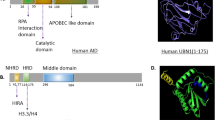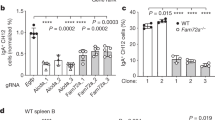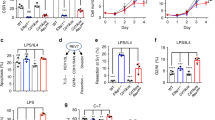Abstract
Activation-induced cytidine deaminase (AID) is a protein required for B cells to undergo class switch recombination and somatic hypermutation (SHM)—two processes essential for producing high-affinity antibodies1. Purified AID catalyses the deamination of C to U on single-stranded (ss)DNA2,3,4. Here, we show in vitro that AID-catalysed C deaminations occur preferentially on 5′ WRC sequences in accord with SHM spectra observed in vivo. Although about 98% of DNA clones suffer no mutations, most of the remaining mutated clones have 10–70 C to T transitions per clone. Therefore, AID carries out multiple C deaminations on individual DNA strands, rather than jumping from one strand to another. The avid binding of AID to ssDNA could result from its large net positive charge (+11) at pH 7.0, owing to a basic amino-terminal domain enriched in arginine and lysine. Furthermore, AID exhibits a 15-fold preference for C deamination on the non-transcribed DNA strand exposed by RNA polymerase than the transcribed strand protected as a RNA–DNA hybrid. These deamination results on ssDNA bear relevance to three characteristic features of SHM: preferential mutation at C sites within WRC hotspot sequences, the broad clonal mutagenic heterogeneity of antibody variable regions targeted for mutation5,6, and the requirement for active transcription to obtain mutagenesis7,8.
This is a preview of subscription content, access via your institution
Access options
Subscribe to this journal
Receive 51 print issues and online access
$199.00 per year
only $3.90 per issue
Buy this article
- Purchase on Springer Link
- Instant access to full article PDF
Prices may be subject to local taxes which are calculated during checkout



Similar content being viewed by others
References
Kinoshita, K. & Honjo, T. Unique and unprecedented recombination mechanisms in class switching. Curr. Opin. Immunol. 12, 195–198 (2000)
Bransteitter, R., Pham, P., Scharff, M. D. & Goodman, M. F. Activation-induced cytidine deaminase deaminates deoxycytidine on single-stranded DNA but requires the action of RNase. Proc. Natl Acad. Sci. USA 100, 4102–4107 (2003)
Chaudhuri, J. et al. Transcription-targeted DNA deamination by the AID antibody diversification enzyme. Nature 421, 726–730 (2003)
Dickerson, S. K., Market, E., Besmer, E. & Papavasiliou, F. N. AID mediates hypermutation by deaminating single stranded DNA. J. Exp. Med. 197, 1291–1296 (2003)
Liu, Y. J. et al. Normal human IgD+IgM- germinal center B cells can express up to 80 mutations in the variable region of their IgD transcripts. Immunity 4, 603–613 (1996)
Rada, C. et al. Immunoglobulin isotype switching is inhibited and somatic hypermutation perturbed in UNG-deficient mice. Curr. Biol. 12, 1748–1755 (2002)
Maizels, N. Somatic hypermutation: how many mechanisms diversify V region sequences? Cell 83, 9–12 (1995)
Peters, A. & Storb, U. Somatic hypermutation of immunoglobulin genes is linked to transcription initiation. Immunity 4, 57–65 (1996)
Muramatsu, M. et al. Class switch recombination and hypermutation require activation-induced cytidine deaminase (AID), a potential RNA editing enzyme. Cell 102, 553–563 (2000)
Revy, P. et al. Activation-induced cytidine deaminase (AID) deficiency causes the autosomal recessive form of the Hyper-IgM syndrome (HIGM2). Cell 102, 565–575 (2000)
Gerber, A. P. & Keller, W. RNA editing by base deamination: more enzymes, more targets, new mysteries. Trends Biochem. Sci. 26, 376–384 (2001)
Muramatsu, M. et al. Specific expression of activation-induced cytidine deaminase (AID), a novel member of the RNA-editing deaminase family in germinal center B cells. J. Biol. Chem. 274, 18470–18476 (1999)
Petersen-Mahrt, S. K., Harris, R. S. & Neuberger, M. S. AID mutates E. coli suggesting a DNA deamination mechanism for antibody diversification. Nature 418, 99–103 (2002)
Di Noia, J. & Neuberger, M. S. Altering the pathway of immunoglobulin hypermutation by inhibiting uracil-DNA glycosylase. Nature 419, 43–48 (2002)
Bebenek, K. & Kunkel, T. A. Analyzing the fidelity of DNA polymerases. Methods Enzymol. 262, 217–232 (1995)
Rogozin, I. B. & Kolchanov, N. A. Somatic hypermutagenesis in immunoglobulin genes. II. Influence of neighbouring base sequences on mutagenesis. Biochim. Biophys. Acta 1171, 11–18 (1992)
Berek, C. & Milstein, C. The dynamic nature of the antibody repertoire. Immunol. Rev. 105, 5–26 (1988)
Dorner, T., Foster, S. J., Brezinschek, H.-P. & Lipsky, P. E. Analysis of the targeting of the hypermutational machinery and the impact of subsequent selection on the distribution of nucleotide changes in human VHDJH rearrangements. Immunol. Rev. 162, 161–171 (1998)
Rogozin, I. B., Pavlov, Y. I., Bebenek, K., Matsuda, T. & Kunkel, T. A. Somatic mutation hotspots correlate with DNA polymerase eta error spectrum. Nature Immunol. 2, 530–536 (2001)
Shapiro, G. S., Aviszus, K., Murphy, J. & Wysocki, L. J. Evolution of Ig DNA sequence to target specific base positions within codons for somatic hypermutation. J. Immunol. 168, 2302–2306 (2002)
Ramiro, A. R., Stavropoulos, P., Jankovic, M. & Nussenzweig, M. C. Transcription enhances AID-mediated cytidine deamination by exposing single-stranded DNA on the nontemplate strand. Nature Immunol. 4, 452–456 (2003)
Gearhart, P. J. & Bogenhagen, D. F. Clusters of point mutations are found exclusively around rearranged antibody variable genes. Proc. Natl Acad. Sci. USA 80, 3439–3443 (1983)
Betz, A. G., Rada, C., Pannell, R., Milstein, C. & Neuberger, M. S. Passenger transgenes reveal intrinsic specificity of the antibody hypermutation mechanism: Clustering, polarity, and specific hot spots. Proc. Natl Acad. Sci. USA 90, 2385–2388 (1993)
Michael, N. et al. Effects of sequence and structure on the hypermutability of immunoglobulin genes. Immunity 16, 123–134 (2002)
Goodman, M. F. Error-prone repair DNA polymerases in prokaryotes and eukaryotes. Annu. Rev. Biochem. 71, 17–50 (2002)
Kunkel, T. A., Pavlov, Y. I. & Bebenek, K. Functions of human DNA polymerases η, κ, and ι suggested by their properties, including fidelity with undamaged DNA templates. DNA Repair 2, 135–149 (2003)
Martin, A. & Scharff, M. D. AID and mismatch repair in antibody diversification. Nature Rev. Immunol. 2, 605–614 (2002)
Acknowledgements
This work was supported by National Institutes of Health Grants. P.P. and R.B. were supported on an NIH-NIA training grant. The authors acknowledge the intellectual contributions and encouragement of M. D. Scharff regarding all aspects of this work.
Author information
Authors and Affiliations
Corresponding author
Ethics declarations
Competing interests
The authors declare that they have no competing financial interests.
Supplementary information
Rights and permissions
About this article
Cite this article
Pham, P., Bransteitter, R., Petruska, J. et al. Processive AID-catalysed cytosine deamination on single-stranded DNA simulates somatic hypermutation. Nature 424, 103–107 (2003). https://doi.org/10.1038/nature01760
Received:
Accepted:
Published:
Issue Date:
DOI: https://doi.org/10.1038/nature01760
This article is cited by
-
Learning mutational signatures and their multidimensional genomic properties with TensorSignatures
Nature Communications (2021)
-
Single-stranded DNA binding proteins influence APOBEC3A substrate preference
Scientific Reports (2021)
-
Methods and cell-based strategies to produce antibody libraries: current state
Applied Microbiology and Biotechnology (2021)
-
Nanobodies from camelid mice and llamas neutralize SARS-CoV-2 variants
Nature (2021)
-
De novo gene mutations in normal human memory B cells
Leukemia (2019)
Comments
By submitting a comment you agree to abide by our Terms and Community Guidelines. If you find something abusive or that does not comply with our terms or guidelines please flag it as inappropriate.



